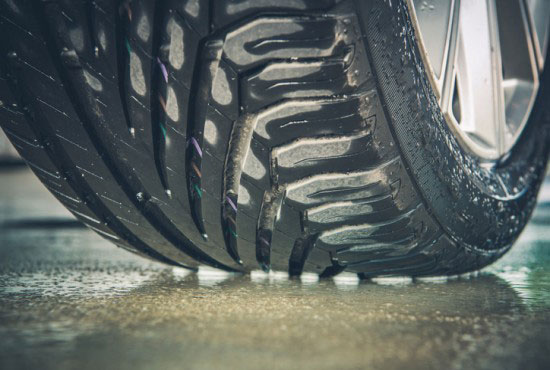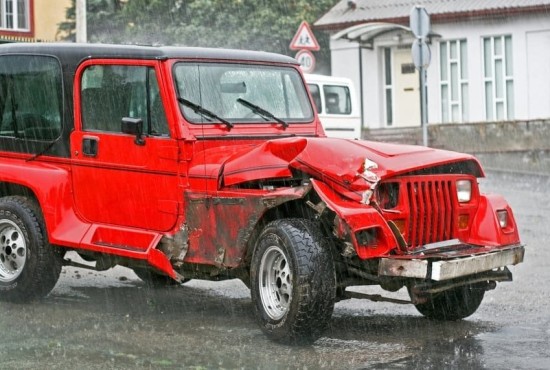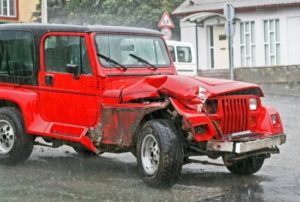When considering safety issues with vehicles people in the south consider hydroplaning because we see a lot of rain and wet pavement. I have been asked if Jeeps hydroplane easily since they are designed to have better traction.
Jeeps are rear-wheel drive vehicles and under the right conditions, they will hydroplane. I cannot say that they actually hydroplane any easier than any other vehicle of similar weight and size.
To demystify hydroplaning and understand this possible problem let’s look further into what it is and why it happens.
Hydroplaning

When water is on the roadway your vehicle can lose traction and begin to be moved on top of a film of water.
Dangers of hydroplaning:
When a vehicle hydroplanes, you could lose control, and the vehicle could strike another vehicle or leave the roadway. If you are driving on a road that has a steep incline on either side your Jeep could roll over or flip when it leaves the roadway.
Possible loss of life can occur in accidents like this. If you are on a busy interstate when your vehicle starts to hydroplane there is a possibility of causing a multi-car pile-up.
How to Avoid Hydroplaning in Your Jeep
Hydroplaning occurs because of water on the roadway. Sometimes this is obvious because it is raining or has just finished raining. You can also hydroplane in water that has pooled because of someone washing their parking lot and large amounts of water on the road surface.
There are safety measures that you can take that will reduce the possibility of you hydroplaning.
These include:
- Slow down when traveling over wet roads. Hydroplaning can occur at speeds as low as 35 mph if the conditions are just right. The faster you are going the less time your tires have to push the water on the road out of your way and the more likely it is that you will hydroplane.
- Never drive on tires that have a tread depth that is at or below 2/32nd of an inch. Worn tires are one of the main causes of hydroplaning accidents and blowouts that cause severe accidents. Use the penny check to see if your tires have adequate amounts of the tread. Take a penny from your pocket and place the penny between the treads of the tire. You want to position the penny so the head of Abraham Lincoln is facing the base portion of the tread groove. If you can see all of Abraham Lincoln’s head then your tire tread is dangerously low.
- Keep your tires properly inflated to reduce hydroplaning.
- Do not slam on your brakes while driving over wet surfaces.
- Do not try to switch lanes when the rain is falling at rates great enough to create a water depth that equals 1/10th of an inch.
- Do not use cruise control if you are driving in the rain. When using manual control you can lift your foot from the accelerator and slow down if needed and you have greater control over the situation.
- Steer clear of puddles of water if you can. If you cannot avoid the puddle drive as slowly as possible through them.
- Keep an increased distance between you and the other traffic on the roadway so if you or another driver hydroplanes there is less of a chance that you will collide with each other.
- Watch the vehicle in front of you. If you see the vehicle in front of you leaving tracks on the wet pavement that is an indication that there is enough water on the pavement to cause you to hydroplane. Steer your vehicle so that you can avoid those tracks.
- Be sure to rotate your tires every 5,000 miles. By doing this you increase the length of time the tires have optimum tread making contact with the road.
What To Do If You Hydroplane

When you do find your vehicle hydroplaning you can take action that will help to reduce the possibility of having a severe accident.
- Do NOT panic. Stay as calm as possible. When you panic you tend to make rash decisions and jerky movements that can cause you more trouble.
- Take your foot off the accelerator and do NOT slam on those brakes. Taking your foot off the accelerator will allow the vehicle to slow down without forcing it into a worse situation. If you slam on the brakes, you can cause the vehicle to lose even more traction which will intensify the hydroplaning effect.
- Hold the steering wheel with both hands and keep it steady. Do NOT move the wheel in either direction. Maintain the position the wheel was in at when the hydroplaning started.
- Do not just come to a stop on the road when your vehicle stops hydroplaning. Slowly maneuver the vehicle to the side of the road at the safest place and then pull over. Nothing is wrong with your vehicle you are simply pulling over to gather your composure.
Pro Tips:
- If at all possible, stay off the roads when it is raining very hard and fast. If you are already on the roads pull over and wait for the rain to let up before you proceed.
- Heavier vehicles are less likely to hydroplane. This is one reason why a Jeep might hydroplane more quickly than some other vehicles.
- Buy tires that are designed to minimize hydroplaning and maximize traction on wet roadways. Touring tires and performance tires are both good choices. Touring tires will create a smoother ride and their tread patterns have slots and sipes that are beneficial when you are driving on wet roads or even when you are driving through snow. Performance tires are designed to resist hydroplaning but if you live in an area where the roads may freeze choose the All-season performance tire.
- If you have to turn your steering wheel during a hydroplane situation turn in the direction the vehicle is traveling. Do not try to turn the opposite way and make the vehicle come out of the skid.
- Turn your emergency flashers on when driving through heavy rain so you can be sure the people behind and around you know that you are there.
FAQs
Why Do Jeeps Hydroplane Worse Than Some Other Vehicles?
Rear-wheel drive vehicles are more likely to hydroplane than any other vehicle. The fact that Jeeps are rear-wheel drive can increase their tendency to hydroplane.
What Increases The Odds That A Jeep Will Hydroplane?
The tires. If the tire has low air pressure like many Jeep tires have when you first come off a sandbar then the vehicle is more likely to hydroplane.
What Is The Difference Between Hydroplaning and Sliding on Wet Pavement?
When you apply the brakes too hard on wet pavement your vehicle may slide and skid out of control. When water is rushing faster than the tires can move it your car can be lifted on top of a thin layer of water and that is hydroplaning.
Final Thoughts
Jeeps are lighter than many other vehicles and that adds to their tendency to hydroplane. Jeeps are rear-wheel drive and that adds to their tendency to hydroplane. With careful driving maneuvers and attention to the weather and road conditions, your Jeep should travel over wet surfaces safely.
Related Articles
1. Are Jeep Wranglers Good in The Snow?
2. Do Jeep Wranglers Flip Over Easily

